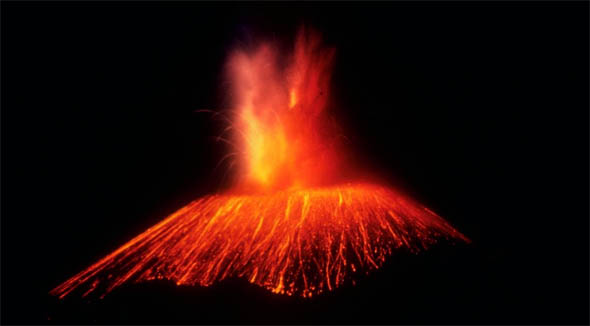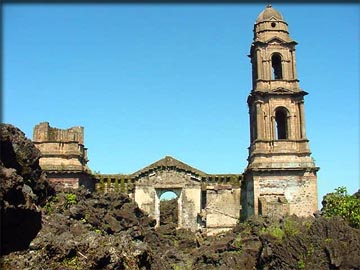|
Paricutin: The Volcano in a Cornfield
On February 20, 1943, Dionisio Pulido was working in his cornfield just outside the Tarascan Indian village of Paricutin, Mexico. He and his family had spent the day getting ready for the spring sowing by clearing the field of shrubbery, putting it in piles and burning it. At about four in the afternoon, Pulido left his wife and moved to a different field so that he could set fire to a new pile. When he arrived he noticed something strange: on top of a small hill in the field a huge crack, over six feet wide and 150 feet (47m) long, had appeared in the earth. At first Pulido wasn't concerned, the crack only looked like it was about a foot deep. As he was lighting the pile of branches, however, the sound of thunder rumbled across the field and the ground began to shake. Pulido turned to look back towards the crack and saw that the ground there had swelled up over six feet in height and fine gray ashes were pouring out of the hole. "Immediately more smoke began to rise with a hiss or whistle, loud and continuous; and there was a smell of sulfur," Pulido later told witnesses. Pulido became terrified by these events and tried to find his wife and sons, but couldn't. He tried to rescue his team of oxen, but they had disappeared also. Despairing that he would never see any of them again, he jumped on his horse and rode to town. There he was happy to find his family and friends waiting for him. "They were afraid that I was dead and that they would never see me again," said Pulido. What had appeared in Pulido's cornfield was a new volcano. The incident at Paricutin would be the first time scientists would be able to observe a volcano from birth through extinction. What they would learn through these events would help them understand the powerful forces deep in the earth that shape the surface of our planet. Trans-Mexican Volcanic Belt The town of Paricutin was located in the heart of the Trans-Mexican Volcanic Belt, an area running 600 miles (900 km) east to west across central-southern Mexico. The belt includes the Sierra Nevada mountain range (which is an extinct set of volcanoes) along with thousands of smaller cinder cones and volcanic vents. Volcanic activity over millions of years has created a high plateau of rock deposits 6,000 feet (1.8km) deep. The soil, because of its volcanic origin, contains a wide variety of common elements which are easy for plants to absorb. This makes the land very fertile. The soil, combined with moist winds from the Pacific Ocean, makes the belt the most productive farmland in Mexico. Even though the belt had a long history of volcanic activity, the residents of Paricutin thought they had been hearing the sound of normal thunder in the weeks that preceded the eruption, though they were puzzled by the lack of storm clouds in the sky. What was producing the sound, however, was the movement of magma deep inside the earth. Soon, however, residents also began feeling tremors in the ground, hinting of what was to come. After its startling appearance, the volcano grew rapidly. That first evening Celedonio Gutierrez, who witnessed the eruption from the town remembered, "…when night began to fall, we heard noises like the surge of the sea, and red flames of fire rose into the darkened sky, some rising 800 meters or more into the air, that burst like golden marigolds, and a rain like artificial fire fell to the ground." The volcano grew by ejecting both lapilli-sized fragments, which range from the diameter of a pea to that of a walnut, along with larger "bomb" fragments. The bombs are often still molten when they are thrown from the volcano and produce bright parabolic streaks in the sky as they fall to the ground. Because they are still soft while flying through the air, the bombs form into a streamlined, aerodynamic shape. As the bombs and lapilli build up around the base of the eruption, they form a steep cone shape often referred to as a scoria, or cinder cone. In a little more than 24 hours the cone of the Paricutin volcano had grown to over 165 feet (50m). Within six more days it had doubled that height. World Attention In March, about a month after the eruption started, William F. Foshag, a curator of minerals at the U.S. National Museum, arrived. Together with his Mexican counterpart, Dr. Jenaro González-Reyna, Foshag would spend the next several years documenting the life cycle of the volcano. Froshag was responsible for gathering many of the samples and photographs from Paricutin that are still used by scientists today while doing volcanic research. The sudden appearance of a new volcano caught the attention of the world. Newspaper and magazine reporters rushed to the area. Life Magazine featured a picture of Foshag with the volcano in the background. Pilots of airliners would point out the cone to fascinated passengers as they flew by it. Hollywood even got into the act by shooting a film, Captain from Castile, in the region and using the volcano as a dramatic backdrop. While the residents of Paricutin might have been happy about the work they got as extras in the movie, it was hardly compensation for the damage the volcano did. In June of 1943 lava started flowing toward the village which had to be evacuated. A few months later the lava also rolled over the nearby town of San Juan. Eventually all that was left of the settlements was the church towers which rose above a sea of lava. A frozen, rugged sea that by the time it has stopped flowing covered 10 square miles. Volcano Types Volcanoes come in three basic types (though sometimes scientists include supervolcanoes as a fourth type). Shield volcanoes are broad, dome-like structures that can grow to over 60 miles (100km) wide. Instead of violent, explosive eruptions they are characterized by steady lava fountains and flows that broaden the size of the volcano. The volcanoes of Hawaii fall into this category. Stratovolcanoes are the most violent and dangerous of volcanoes. Their slopes rise slowly at first and then become very steep with a narrow vent at the top. Stratovolcanoes often have explosive eruptions, and then go dormant for decades or even centuries. Mt. St. Helens, in the United States Pacific Northwest, is a Stratovolcano. The final type of volcano is one like Paricutin, a scoria cone. This type of volcano can appear suddenly and build a large conic-shaped mountain with steep slopes. They often erupt for less than a decade, then go dormant and never erupt again. The type of eruptions from such cones are known as Strombolian eruptions because the lava flows out of a single vent that resembles those at the Stromboli volcano in Italy. End of the Volcano Paricutin was very active in its first year, growing to four-fifths of its final 1,353 foot (424m) height. During the peak of its activity that year, ashes from the volcano drifted as far as 200 miles to the east and fell on Mexico City. With each following year, however, the volcano became less active until, after a final spectacular spasm, it finally went dormant in 1952. By then the damage had been done, however. In addition to the lava fields, there were also 20 square miles of volcanic sand deposited around Paricutin and almost all vegetation had been destroyed within a few miles of the crater. Hundreds of people had been resettled to other locations and had to find new livelihoods. Before leaving his home for the final time Pulido put a sign on his land. It read "This volcano is owned and operated by Dionisio Pulido." Paricutin might have taken his cornfield, but the farmer still retained his sense of humor.
|


